![]()
![]()
![]()
Use LEFT and RIGHT arrow keys to navigate between flashcards;
Use UP and DOWN arrow keys to flip the card;
H to show hint;
A reads text to speech;
64 Cards in this Set
- Front
- Back
- 3rd side (hint)
|
Mandibulata |
Myriapoda
Hexapoda
Crustacea
|
|
|
|
Myriapoda |
millipedes
centipedes |
|
|
|
Hexapoda |
Enthognatha
Insecta |
|
|
|
Crustacea |
Malacostraca
Copepoda
Cirripedia
Branchiopoda
|
|
|
|
Malacostraca |
Isopoda
Amphipoda
Decapoda
Euphausiacea
Stomatopoda |
|
|
|
Decapoda |
Caridea
Anomura
Branchyura
Astacidea
|
|
|
|
Caridea |
Decapoda (Malacostraca--crustacea--mandibulata)
shrimp
|
|
|
|
Anomura |
Decapoda (Malacostraca--crustacea--mandibulata)
Hermit crabs, etc
|
|
|
|
Branchyura |
Decapoda (Malacostraca--crustacea--mandibulata)
true crabs |
|
|
|
Astacidea |
Decapoda (Malacostraca--crustacea--mandibulata)
crayfish, lobster |
|
|
|
apterygotes |
insects without wings |
|
|
|
pterygote |
insects with wings (2 pairs), OR
secondarily lost 1 or both pairs |
|
|
|
Insect head |
fusion of 3 segments
eyes (compound and simple) antennae mouth parts |
|
|
|
Labrum |
insect mouthpart
upperlip
|
|
|
|
mandibles |
insect mouthpart |
|
|
|
maxillae |
insect mouthpart
sensory palps |
|
|
|
labrium |
insect mouthpart
lower lip
derived from 2nd maxillae pair (now fused)
sensory palps |
|
|
|
hypopharynx |
insect mouthpart; hidden by labrium
used for tasting food, lubricating it with saliva, and guiding it to mouth |
|
|
|
Thorax |
prothorax mesothorax metathorax
1 pr walking legs/segment
1 pr wings-- meso and meta |
|
|
|
Abdomen |
11 segments terminal segments for copulation, egg laying
|
|
|
|
ovipositor |
insect Abdomen (females only)
|
|
|
|
cerci |
insect Abdomen
2
sensory |
|
|
|
spiracles |
insect Abdomen, along the side
breathing pores |
|
|
|
tympanum |
insect Abdomen, first segment
sound reception |
|
|
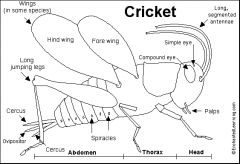
External features (cricket) |
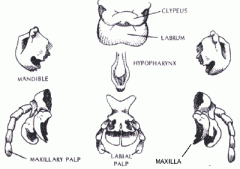
Mouthparts:
labrum mandible hypopharynx maxilla labium
|
|
|

mouthpart diversity |
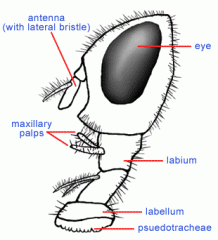
Lab: butterfly
housefly --pictured
mosquito (has antennae and palps on sides of labium) |
|
|
|
tacheal tubules` |
internal gas exhange chamber
closed by spiracle
prevents evaporative water loss
|
|
|
|
malpighian tubules |
excretion (collect waste from hemocoel)
osmoregulation (absorb H2O)
between mid and hindgut |
|
|
|
Ametabolous development |
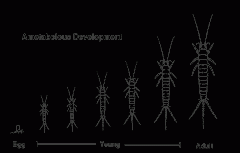
egg -- adultlike juvenile ---- adult
young exactly like adults, but smaller and not sexually mature
primitive wingless insects (silverfish) |
|
|
|
Hemimetablous (exopterypote) development
|
egg -- nymph --adult ; molting
nymph is adultlike, use same food BUT underdeveloped wings until adults
ex grasshopper, cockroach |
exoptrypote = outside wings |
|
|
Holometabolous (exopterypote) development |
eggs -- worm-like larvae --pupa --- adult
moulting internal development of wings, etc
pupa--complete metamorphosis
butterflies (caterpillars), bees, flies (maggots), beetles (grubs)
|
exoptrypote = outside wings |
|
|
development summary |
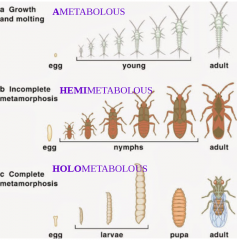
Ametabolous
Hemimetablous
Holometabolous
|
|
|
|
Crustacea |
2nd pr antennae
biramous/polyramous appendages (secondarily uniramous) |
|
|
|
Branhipoda |
crustacea --- "fairy shrimp"
swim upside down
phyllopods
epipods (exites)
thin exoskeleton, pressurized haemel fluid |
|
|
|
phyllopods |
Branhipoda (crustacea)
"leaf feet"
gas X, filter feeding, locomotion (paddling)
11 pairs, 1 pr/thorax appendage |
|
|
|
epipod (exite) |
extension of the basal protopod |
|
|
|
Copepoda |
crustacea
planktonic; largest biomass
pelagic, benthic, parasitic
caudal furca |
|
|
|
caudal furca (ramus) |
Copepoda (crustacea)
forked tail |
|
|
|
Copepod body plan |
abdomen -- 7 segments, 4 w biramous appendages
caudal furca
|
|
|
|
Cirripedia |
crustacea--- "barnacles" acorn, goose-neck (stalked) sessile nauplis larva --- cypris larvae cirri free-living, parasitic |
|
|
|
cirri |
emerge from opercular plates to water column
"rake" seawater for food particles
|
|
|
|
Malacostraca |
head,thorax, abdomen
fused carapice if present
cephalothorax
thorax = 8 seg abdomen = 6 + telson
thoracopods: maxillipeds pereopods
pleopods (abdomen) uropods |
|
|
|
maxillipeds |
thoracopods
accessory mouthpart
associated gills |
|
|
|
pereopods |
thoracopods that are not maxillipeds
walking legs
associated gills |
|
|
|
pleopods |
appendages of abdomen, biramous
males = 1st 2 prs for sperm transer females = all prs to carry eggs
short bouts of swimming |
|
|
|
uropods |
pleopods with specialized function (depending on group)
+ telson = tailfan tail flip escape response |
|
|
|
Isopoda |
Malacostraca
no carapace
1 pr maxillipeds 7 pr pereopods--crawling, (5) gas X + swimming
compound eye w/ no stalk
cehpalon pereon pleon |
|
|
|
Amphipoda |
Malacostraca
c-shaped no carapace unstalked compound eye 1 pr maxillipeds
1st 2 pereppod pairs --subchelate ends (grasping) 3 pr pleopods 3 pr uropods --scleotized - locomotion/burrow |
|
|
|
Euphausiacea |
Malacostraca "krill"
no maxillipeds (shrimp = 1 pr) 8 pr pereiopods w/ feathery gills biramous setose (bristles) bioluminescent |
|
|
|
Stomatopoda |
Malacostraca "mantis shrimp"
carapace only over half of thorax
enlarged 2nd thoracopod pr (prey capture)
massive tail fan (sclerotized telson + uropods) --shield during fights, block burrow entry |
|
|
|
Decapoda |
Malacostraca
well-developed carapace
branchiostegites
chelipeds
thoracopods 1st 3 pr =maxillipeds 1st 1 pr pereopod = cheliped, 4 other prs
abdomen 5 pr pleopod (biramous) 1 pr uropod
|
|
|
|
branchiostegites |
space formed by the lateral walls of the carapace; where gills go
|
|
|
|
cheliped |
1st pair of 5 pereopods
enlarged, chelate
tear chunks off/crush prey |
|
|
|
Astacidea |
decapod (Malacostraca) lobsters, crayfish
elongated abdomen
tailfan (abdomen + telson)
|
|
|
|
Astacidea appendages |
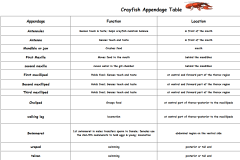
walking = 4 posterior pereopods
feeding = maxilla, chelipeds, mandibles
swimming = pleopods (reduced), uropod, telson
head=5 pr thorax=8 pr abdomen = 6 |
|
|
|
Astacidea Cephalothorax |
head: 2 pr antennae + mandibles + 2 pr maxillae
thorax: 3 pr maxillipeds, 1 pr chelipeds, 4 pr pereopods (walking legs) |
|
|
|
Astacidea abdomen |
5 pr pleopods (biramous), uropod, telson |
|
|
|
maxillae |
accessory mouthpart
2nd pr = circulate water thru gill chamber for gas X
|
|
|
|
Antennules |
1 pr, biramous
balance |
|
|
|
Antennae |
1 pr
excretory opening at base |
|
|
|
Mandibles |
1 pr, sclerotized
chewing |
|
|
|
Caridea |
decapod (Malacostraca) shrimp
specialized for swimming rostrum paired compound eyes |
|
|
|
Brachyura |
decapod (Malacostraca) true crabs
reduced, tucked abdomen reduced pleopods (no swimming)
males= 1st 2 pr pleopods for sperm transfer females= brood egg mass b/w cephalothorax + abdomen
chelipeds
4 pr walking legs |
|
|
|
Anomura |
decapod (Malacostraca) hermit crabs, mud shrimp, lithoid crabs
variable abdomen sizes
3 pr walking legs 4th pereopod = reduced, in gill chamber to clean
"grippers" from abdomen to columella
enlarged right chelioped to act as operculum |
|

